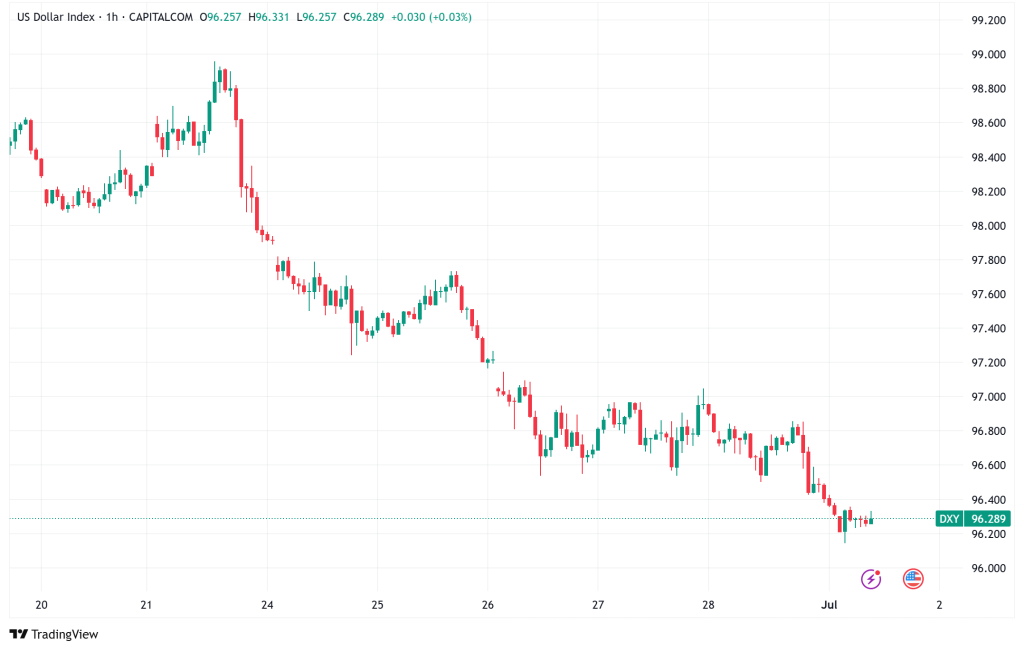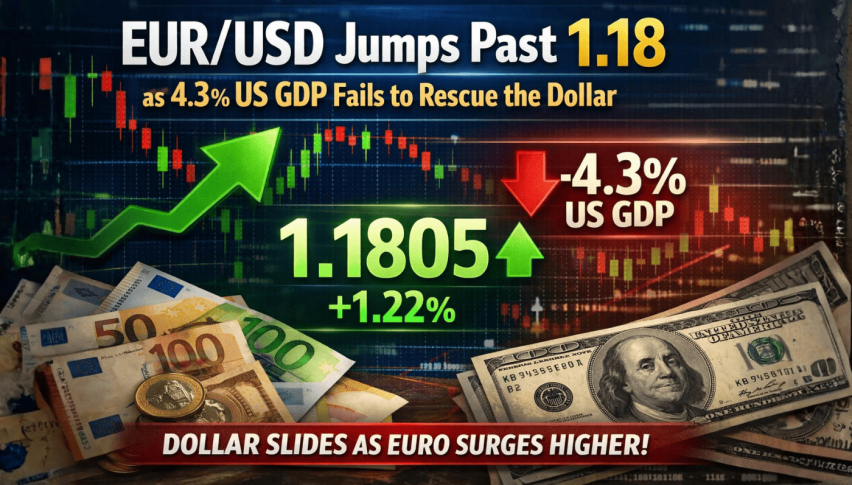US Dollar Index Plummets to Historic Lows as Trump Policies Trigger Currency Crisis
The US Dollar Index (DXY) fell more than 10% in the first half of 2025, marking the currency's worst six-month performance since 1973. This

The US Dollar Index (DXY) fell more than 10% in the first half of 2025, marking the currency’s worst six-month performance since 1973. This was the biggest drop in more than five decades. The dollar has lost a lot of ground against key global currencies as investors sell off dollar-denominated assets because they are worried about President Donald Trump’s economic ideas. The dollar is now trading close to the important 97 mark.

Technical Analysis Points to Further Weakness
The DXY’s drop from its 52-week high of 110 is a terrible 13% correction, and the index is now around 96.70, which is the lowest level since March 2022. The daily chart pattern shows that the index has been under negative pressure for a long time, with losses for nine days in a row as of Tuesday.
The technical breakdown has been very bad, with important support levels not holding. The index’s inability to stay above 97 signals that it will continue to go down, and analysts point to structural faults in the chart pattern that could cause it to go down even more.
Across the board, currency pairs are showing that the dollar is weak. The EUR/USD has gone up 13% this year, going above $1.17 and going against Wall Street’s projections that the euro and dollar will be equal. At the same time, commodities currencies like the Australian and New Zealand dollars are showing positive price action. For example, the AUD/USD is building an ascending expanding wedge pattern as it gets closer to resistance at 0.6650.
Market Outlook and Key Levels to Watch
Traders are keeping a careful eye on a few important technical levels as they look to the future. The 142 support level is a key battleground for USD/JPY. If it breaks below, it might mean that the dollar is getting weaker. The pair has already failed to break through resistance near 148.30, which shows that the bearish trend is still going strong.
The ISM Manufacturing PMI and other statistics from the manufacturing sector will give us important information about what the Federal Reserve plans to do in July. Later this week, numbers about the job market could change what people think about where monetary policy is going.
Some observers say that the dollar’s drop may be reaching extreme levels, but the technical indicators show that there is still a chance of it going down. Guy Miller, the chief market strategist at Zurich Insurance, thinks that the rate of decline may slow down. He said, “A weaker dollar has become a crowded trade.”
US Policy Uncertainty Drives Investor Exodus
The dollar is falling because of a perfect storm of policy problems during Trump’s second term. The administration’s “big, beautiful bill,” which is a large tax and spending package that the Senate is presently looking at, could add $3.3 trillion to the national debt over the next ten years. This increase in spending has shaken the market’s faith in the US government’s ability to manage its money.
Trump has openly blasted Federal Reserve Chair Jerome Powell for being “too late” to drop rates, which raises major issues about the independence of the central bank. This political meddling has led to forecasts of as many as five rate cuts by the end of 2026, which is bad news for the currency.
“The dollar has become the whipping boy of Trump 2.0’s erratic policies,” said Francesco Pesole, an FX strategist at ING. This shows how unpredictable the present US economy is.
Structural Shifts in Global Investment Patterns
The dollar’s drop isn’t only an indication of cyclical weakness; it’s a hint that global investors are changing how they see US assets. Foreign pension funds and central banks are progressively hedging or lowering their exposure to the dollar, and demand for US Treasury bonds has dropped significantly.
This retreat is especially important because the dollar is usually seen as a safe place to put money when there is global instability. As central banks diversify their reserves, gold prices have reached all-time highs. This shows that people are becoming more cautious about dollar-denominated assets.
Andrew Balls of Pimco said, “There is no immediate threat to the dollar’s role as the world’s reserve currency,” but “that doesn’t mean you can’t have a significant weakening.”
Implications for Global Markets
The dollar’s long-term weakening is changing how money moves around the world and how currencies work. European markets have done very well, with German bonds getting a lot of safe-haven money as investors move away from US assets. The US stock market has done much worse than European benchmarks, even though the S&P 500 hit record highs.
The dollar’s traditional function as a worldwide safe haven has changed because of uncertainties about US policy, rising debt concerns, and a loss of faith in US economic management. The dollar is still the world’s most important reserve currency, but its reputation for safety is plainly fading. This could be a turning moment in the way money moves around the world.
- Check out our free forex signals
- Follow the top economic events on FX Leaders economic calendar
- Trade better, discover more Forex Trading Strategies
- Open a FREE Trading Account


